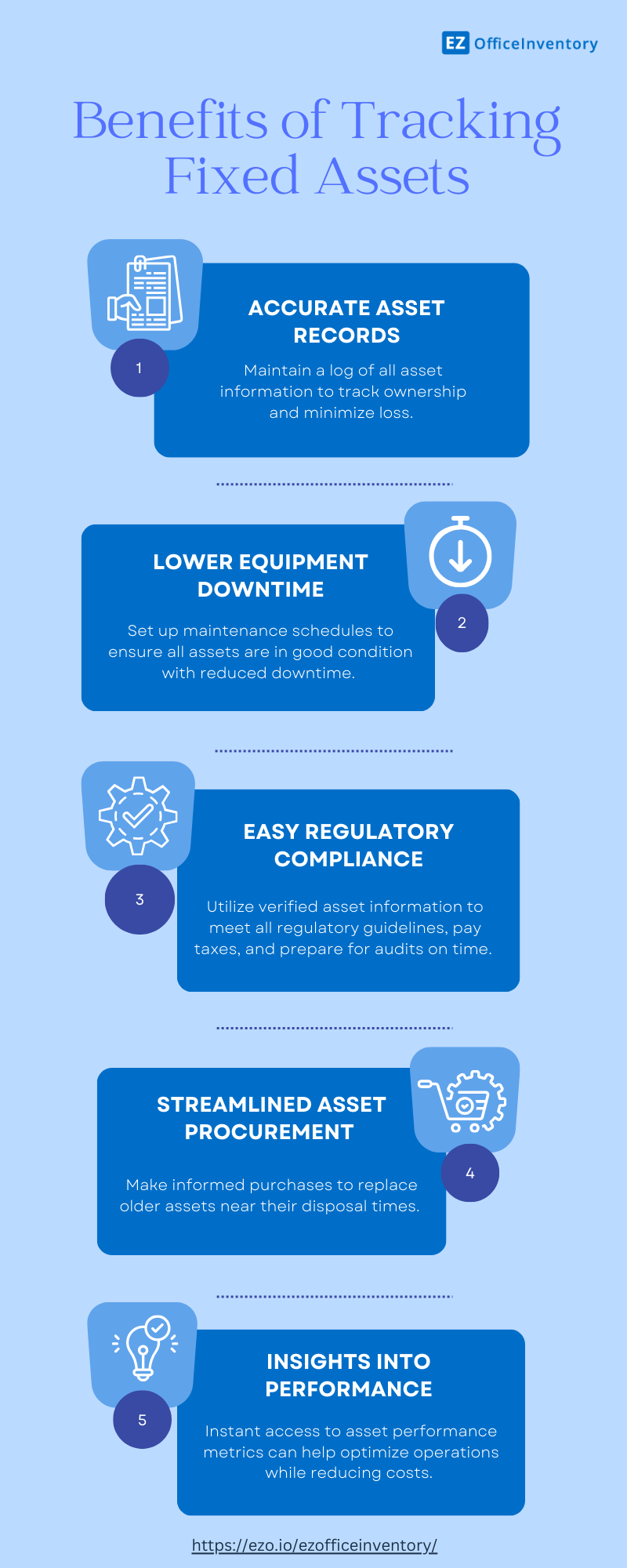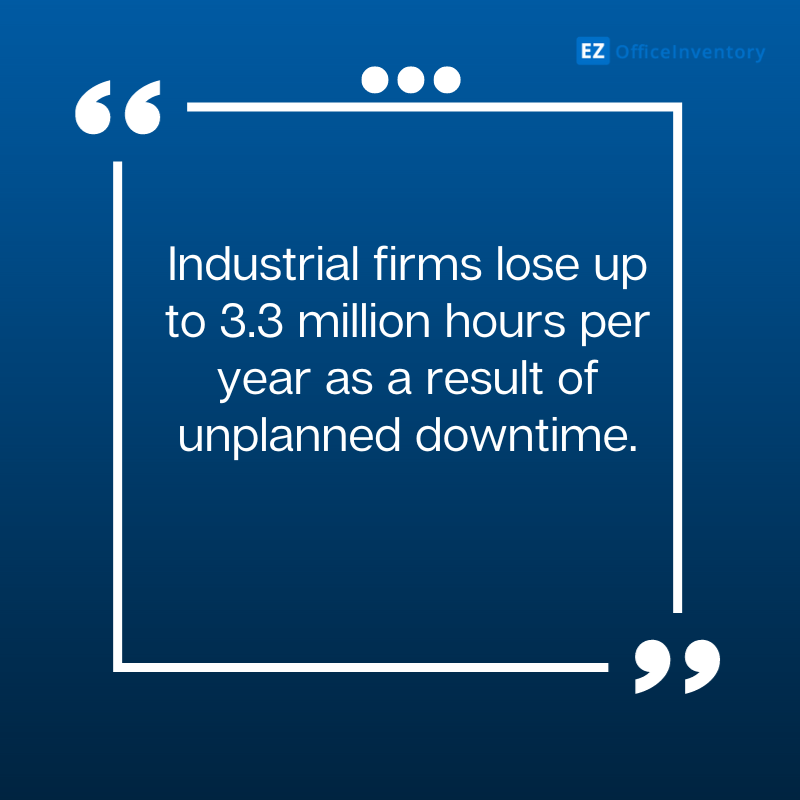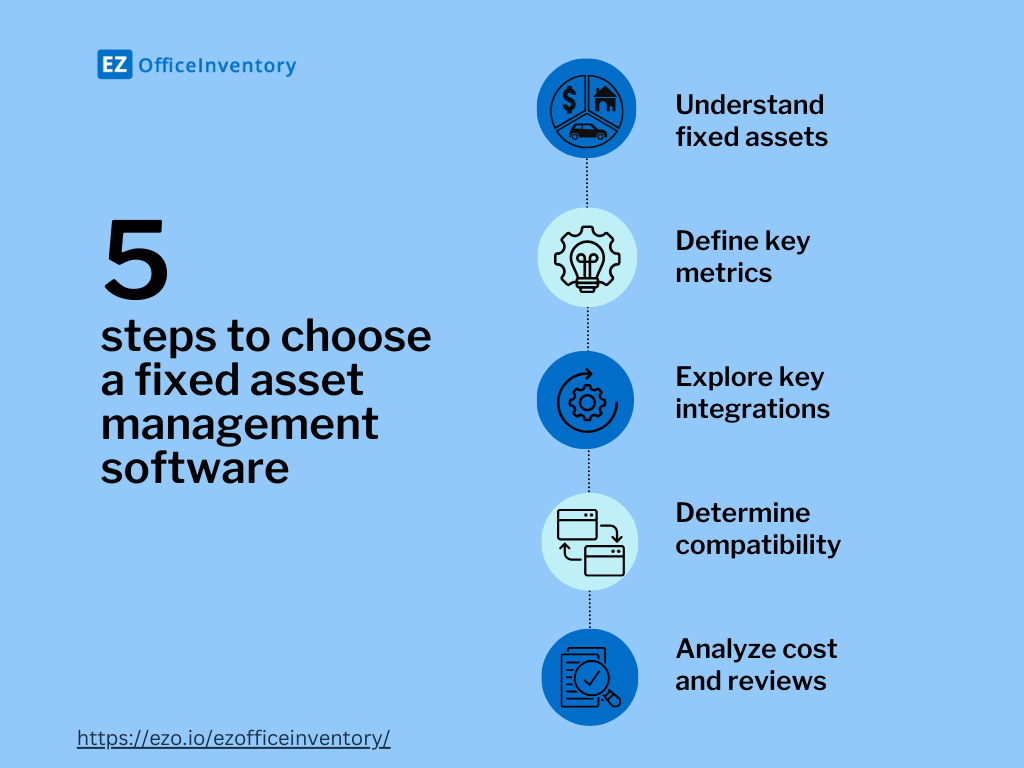Long-term assets that are used for more than one year are generally classified as fixed assets. These assets are high-value capital investments, essential for generating revenue by providing support in production workflows. Based upon their use, fixed assets are not intended to be converted into cash and are subject to regular depreciation. Accordingly, it is important to register and track fixed assets to maintain accurate records at all times.
In order to run smooth business operations it is critical to ensure that fixed assets are always in optimal shape with minimal downtime. A fixed asset management process enables businesses to track utilization, and calculate depreciation for optimal asset performance and longevity.
Why is fixed asset management important?
According to research, 56% of businesses don’t manage the entire lifecycle of their assets and more than 60% are missing key information to manage assets from procurement to disposal. Lack of critical information can make it challenging for organizations to perform accurate financial reporting on assets.
Large organizations can improve organization, maintain transparency and cut down costs by implementing a fixed asset management system. Here are some benefits of managing fixed assets for your organization:
Accurate asset records
Fixed assets are costly and once stolen can take a long time to replace. To tackle such issues, fixed asset management enables organizations to keep a track of all items they own. By using a management process, businesses can easily monitor ownership of assets – improving transparency. In case anything goes missing you can simply log into the system to retrieve details and carry out an investigation.
Lower equipment downtime
In case of an unexpected breakdown, it can take a long time for fixed assets such as heavy machinery to resume functionality. For instance, industrial firms lose up to 3.3 million hours per year as a result of unplanned downtime.
One way to avoid unpredictable downtimes is to implement maintenance strategies for fixed assets. Preventive maintenance sessions include routine inspections to eliminate chances of last minute breakdowns incurring high costs.
Easy regulatory compliance
When dealing with high value assets, there are a lot of regulations and guidelines that organizations have to follow. For example, paying taxes on time for all applicable assets is a simple way to achieve compliance. This can only be done when you have an accurate representation of the value of your fixed assets.
Streamlined asset procurement
Fixed assets are significant capital investments which cannot be replaced and upgraded easily. Buying unnecessary assets means tying up resources which could have been spent elsewhere. A robust fixed asset management system that logs every detail of your assets from the date of purchase to disposal, helps you keep track of useful asset life.
By using a reliable management process, businesses can log in purchase orders when older assets are disposed of or sold at a salvage value– resulting in efficient procurement cycles.
Insights into performance
Fixed assets play a significant role in running day-to-day business operations– impacting productivity and growth. To ensure that your business meets its growth objectives it becomes important to track how your assets are performing at all times.
Having accurate real-time data about fixed assets can assist in making data-driven decisions to optimize cost, labor and time.

What does the fixed asset management process entail?
A fixed asset management process includes tracking all the details of physical assets over their entire life cycle. Let’s take a look at some common components of fixed asset management:
Acquisition
This process includes purchasing or acquiring new assets and documenting all important details in the correct manner. Fixed assets have various associated costs such as installation and setup fees that should be accounted for. A fixed asset management system enables organizations to record real-time information throughout the asset’s life with minimal errors.
Asset registration
After acquiring the asset, the next step is to register it within the system. This can be done by creating a log of critical data including:
- Location
- Quantity
- Availability and condition
- User manuals
- Retirement date
All this data enables you to assess how the asset is being utilized throughout its lifecycle.
Depreciation management
As fixed assets are gradually used over time, their value depreciates with constant wear and tear. In order to maintain the current value for fixed assets, businesses need to devise a depreciation management system. A fixed asset management process ensures that depreciation calculations are always accurately reflected in financial statements on time.
Service and maintenance
Fixed assets are subject to regular use which can increase chances of unpredictable downtime. To avoid unplanned breakdowns, fixed assets need routine maintenance schedules with proper inspection. Timely service sessions improve uptime and prolong the useful life of fixed assets.
Utilization analysis
As a part of the management process, it is important to assess the utilization of fixed assets. If an asset is not performing up to the mark, it can lead to productivity delays and disrupted business operations.
To avoid such roadblocks, organizations can run reports on the performance of fixed assets over time. Data-driven insights make it easier to analyze which assets need to be repaired or replaced.
Also Read: 5 Ways Fixed Assets Can Be Managed Throughout Their Lifecycle

4 reasons you should automate fixed asset management
Manual spreadsheets used to track fixed assets can be difficult to access – resulting in loss of productivity. Research shows that 80% of the employees waste 30 minutes on average per day trying to retrieve information. With the help of an automated solution, businesses can eliminate asset management discrepancies facilitating efficient workflows. Here are some benefits of automated fixed management solutions:
Barcode asset tracking
With the help of an automated solution, organizations can generate barcode tags for all their assets. These unique IDs can be used to track fixed assets throughout their lifecycle. This speeds up the process of creating an inventory as you don’t have to manually enter every detail for your assets.
The barcode tag can be easily scanned and all the related asset information will be retrieved from the software within seconds. Such a system ensures asset data is logged instantly and easily accessible to all– saving time and effort.
Automated depreciation calculation
A software used to track fixed assets will automatically calculate depreciation and salvage value. Accurate depreciation estimates make it easier to determine the value of an asset at any given time. Employees don’t have to manually look up purchase costs and select depreciation methods every time businesses have to file for taxes.
This also helps them determine when an asset is fully depreciated and ready for disposal.
Custodian management
A software records every time an employee checks out a fixed asset for use. Details such as location of use, time duration and condition can also be documented. Access to such information can help businesses minimize chances of misplacement and loss.
Custody management through an automated solution provides transparency and helps validate audits with accurate information.
Instant alerts
Fixed asset downtime can impact operational workflows if teams are not informed about it. Automated fixed asset management enables you to set up alerts and notifications about critical events. You can send an alert each time the excavator is sent for maintenance. This way employees can arrange for alternate options ensuring uninterrupted workflows.
How to choose a fixed asset management software for your business
Implementing a cloud-based software to manage your fixed assets can help eliminate manual processes leaving no room for errors. In order to achieve streamlined fixed asset management, it is important to implement the right type of software.
Let’s look at some key factors to consider when choosing the best software for your business:
Understand your fixed assets
Start by understanding the basic characteristics of your fixed assets. Companies have different types of assets depending on their industry.
For example, healthcare companies deploy specialized medical assets which focus on providing patient care whereas manufacturing firms have heavy equipment and machinery used for production. Once you have listed your fixed asset requirements, you can then start to shortlist software that offer the relevant features and functionality.
Define key business metrics
Any software you choose to work with should help you accomplish your targets. A small company will have different goals than a bigger organization. For instance, if you aim to improve asset visibility then your desired software should have a robust barcode tracking system.
Another common goal for fixed assets is to control costs and improve accountability. This can be achieved by implementing a software that offers insightful asset reports with real time custody tracking at all times.
Explore integrations
Companies work with different types of softwares to manage data, track maintenance tickets and match accounting records. In order to ensure seamless transition to the new software, it is important that you choose the one that is easily able to integrate with your preferred systems.
When it comes to fixed assets, a software that integrates with service desks can be an added plus to resolve maintenance issues.
Determine compatibility
The majority of software solutions offer companies the option to customize their setup according to their workflows. This can be an added benefit to make the software user-friendly and reduce the training time involved. Also, lookout for the types of depreciation methods supported by the software.
Analyze cost and reviews
Along with listing your preferences, keep a track of the reviews and ratings. Doing a comprehensive market analysis helps to filter out the right software according to your budget requirements.

How to get the most out of your fixed asset management system
Choosing the right management software can be a challenging task, but once it is done the next step is to utilize it in the best way possible. Doing so will enable your business to maximize returns and extend the useful life of fixed assets. Here are a few tips on how to implement fixed asset best practices at your organization:
Establish the right processes
It is common for businesses to implement an inventory management process for fixed assets. That can have a negative impact on your performance and productivity. Unlike stock items, fixed assets have different requirements and need to be managed till the end of their useful life.
Design maintenance schedules
In order to ensure minimum downtimes, set up maintenance schedules according to the types of fixed assets you own. For example, some heavy machines and equipment have an annual maintenance requirement. Use robust software to help you set service schedules to avoid last minute breakdowns.
Train your team
If you have established a process, make sure your team knows about it. Educate them about barcode scanning, depreciation methods and audits so there is a lower chance of errors when it comes to handling fixed assets.
Review performance
For a business to grow in the right direction, it is important to review how fixed assets are being used over time. Holding on to old fixed assets can be a roadblock when it comes to scalability. Make sure fixed assets are not being used beyond their useful life. Keep an eye on performance to judge whether your business has grown out of a fixed asset.
Frequently asked questions (FAQs)
What are some examples of fixed assets?
Fixed assets are tangible goods that are expected to be used for more than a year. They are not intended to be converted to cash during their useful life. Some common examples include buildings, heavy machinery, vehicles and furniture.
How to manage fixed assets?
Fixed assets can be managed with the help of a software that offers barcode tagging to track items. Companies can use these labels to enter all relevant information about assets into their system and update details such as disposal date, current value, upgrades,and repairs. Businesses choose different methods to track depreciation for their fixed assets which helps to determine the financial value of the asset at any time.
What does fixed asset management include?
Fixed asset management is a comprehensive process that includes different stages from procurement to disposal. Here are some major steps involved:
- Acquisition
- Track asset utilization
- Calculating depreciation
- Service and maintenance
- Disposing the asset
- Reporting
About EZOfficeInventory
EZOfficeInventory is an asset management software that can help you manage your fixed assets. It offers features such as quick check-in, checkout, maintenance and depreciation tracking to ensure your fixed assets are performing at optimal levels at all times.







